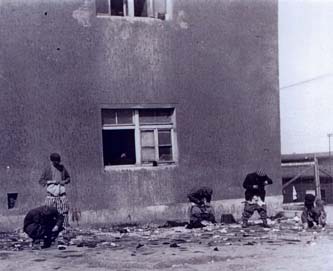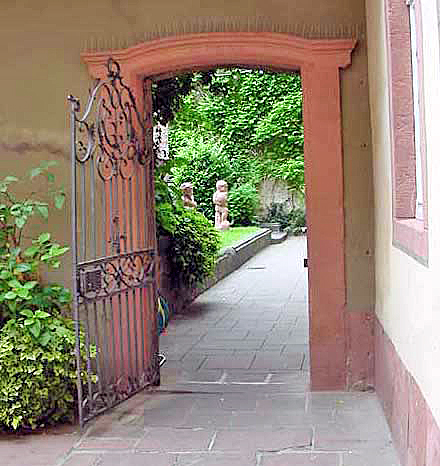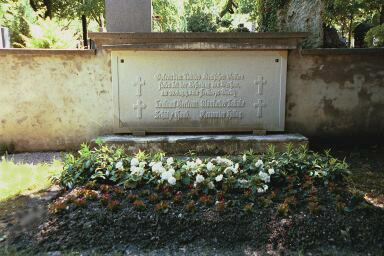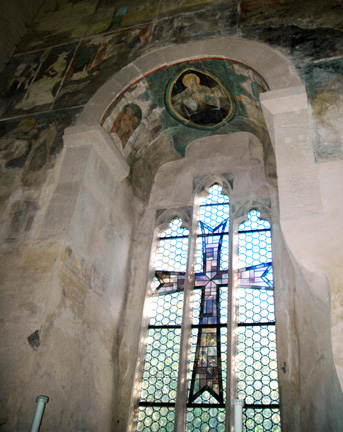I have almost finished reading Bill O’Reilly’s new book, entitled Killing Patton. I previously blogged here about my complaints regarding the book. I was quite critical in my original post. After reading the book more thoroughly, I can now understand why there are so many good reviews of the book.
One of the best parts of the book centers around the story of General Anthony McAuliffe saying “Nuts” to the Germans who wanted him to surrender during the fighting around Bastogne. In the book, there is a photo of General Patton conferring with General McAuliffe. This was America’s finest hour.
On page 47 in the book Killing Patton, the famous slapping incident is mentioned, although it is not pointed out that the slapped soldier, whose name was Pvt. Charles H. Kuhl, was Jewish. According to the book: “Patton thinks nothing of it. […] In the German army, such men are not slapped. They are forced to their knees and a bullet is shot through their brain.”
Many people believe that Patton was killed by Jews, as revenge for the slapping of a Jewish soldier. You can read about the claim that Patton was killed by Jews on this website: http://www.realjewnews.com/?p=594
Many people who are reading this book, will remember the famous movie about Patton, which begins with Patton making a speech on a stage. This quote is from this website: http://www.imdb.com/title/tt0066206/trivia
In reality, George S. Patton slapped and berated two soldiers in Sicily: Private Charles Kuhl on August 3, 1943 and Private Paul Bennett on August 10. Although it has been suggested Patton was sleep deprived, he wrote an entry in his diary after slapping Kuhl, unrepentant in his actions or opinion that Kuhl was a coward. Patton was ordered by Supreme Commander Eisenhower to apologize privately to the soldiers and hospital staff present. Also, in reality the slapping incidents were kept secret from the public for months before the story was broken by reporter Drew Pearson, causing scandal not only for Patton’s conduct, but accusations of cover-up on the part of the Army.
On page 97 of Killing Patton, we read this startling information: “[Joachim Peiper] was an eye-witness to the first gassing of Jewish civilians, including women and children.” Unfortunately, the location of the first gassing of Jewish civilians is not mentioned in the book. I checked with Wikipedia and learned this: “In January 1941, Peiper accompanied Himmler when he inspected Ravensbrück and Dachau concentration camps.[27] In March 1941, together with Karl Wolff and Fritz Bracht, they visited Auschwitz.[28].”
According to many Holocaust historians, the first gassing of the Jews took place at the Chelmno camp: http://www.ushmm.org/wlc/en/article.php?ModuleId=10005194
Now, one of my biggest complaints, about O’Reilly’s book, is about the footnotes. There is a lot of important information in the footnotes, but you cannot find some of this information by looking through the index.
For example, in my original post about the book, I said that the word Gleiwitz was not in the index. However, the word Gleiwitz is mentioned on page 180 in a footnote. Why is this important? Gleiwitz was one of the places to which the Auschwitz prisoners were marched, so that they could be put on trains and taken to camps such as Dachau and Buchenwald.
On page 186 in the book, there is some information about the Germans working on an atomic bomb near the Ohrdruf sub-camp of Buchenwald. This information is too important to be put into a footnote.
On page 243 in the book, we find this: “Hitler had once dreamed of establishing Berlin as the world’s most cosmopolitan city, even though its citizens have long considered him to be an unsophtisticate bore. […] To spite its inhabitants, Hitler had planned to rename the city Germania during the postwar rebuilding, thus wiping Berlin off the map forever.”
I wrote a much different story about Germania on this page of my website: http://www.scrapbookpages.com/Sachsenhausen/ConcentrationCamp/BrickFactory.html
I don’t like the fact that footnotes were used in the book to give important information, and then not included in the index. For example, there is a footnote on page 252, which includes this information: “An estimated eighty thousand Russians died in the battle of Berlin. […] …it is estimated that between eighty thousand and one hundred thousand citizens of Berlin were killed.”
In the book, there is way too much attention on the subject of Auschwitz. There are two whole chapters on this subject. Chapter 15 is about a “German SS guard named Frank Wunsch” who falls in love with a Jewish woman, who is a prisoner in the camp. How is this remotely related to the story of killing Patton?
On page 177 in O’Reilly’s new book, it is mentioned that there were 3 dozen (36) watch towers at Auschwitz? Could we see a photo of the watch towers please?
I blogged about the watch towers at Auschwitz, which were not there until after the camp was liberated: https://furtherglory.wordpress.com/2012/03/08/new-book-of-photos-shows-auschwitz-then-and-now/
It might have made sense if there were two chapters in the book, telling about the Dachau concentration camp, instead of two chapters about Auschwitz.
At the proceedings against the Waffen-SS soldiers, who were accused of the Malmedy Massacre during the Battle of the Bulge, which were held in a building inside the former SS training camp at Dachau, any mention by the defense that American soldiers had killed German POWs, was ordered stricken from the record by the judges of the American Military Tribunal. This information is more important than the fact that an SS soldier at Auschwitz fell in love with a Jewish girl.
After the Dachau camp was voluntarily surrendered to American soldiers under a white flag of truce, SS soldiers in the training camp next door to the concentration camp were lined up and shot by the Americans. When these American soldiers were Court Martialed, General Patton tore up the papers and burned them in his waste basket.
Instead of two chapters on Auschwitz, which have absolutely nothing to do with General Patton, O’Reilly could have included a chapter on Buchenwald, which was one of the camps that Patton visited. I wrote about Patton’s visit to Buchenwald on April 15, 1945, four days after the camp had been liberated : http://www.scrapbookpages.com/Buchenwald/Liberation8.html

Liberated Jews at Buchenwald relieved themselves on the ground
After the Buchenwald prisoners were liberated, they were moved from the prisoner’s barracks to the nicer SS barracks, next door to the concentration camp. General Patton was appalled when he saw the Jews relieving themselves on the ground outside the SS barracks. Is this what caused Patton to turn against the Jews?
Robert Abzug wrote about the reaction of the American liberators to the prisoners:
The following quote is from Abzug’s book entitled Inside the Vicious Heart:
Despite what they knew about what their wards had undergone, some Americans never ceased to wonder why, even after food had been made readily abundant, the survivors pushed and shoved their way to the soup kettle or bread basket. Others were appalled to find some indifferent to nudity and personal cleanliness. Nor was it readily understood why many were slow to volunteer for work, even though it might help the condition of the camp.

Prisoner at the Buchenwald concentration camp, who was indifferent to nudity
This quote is from my website page about Patton at Buchenwald:
In his book, General Patton wrote with great insensitivity that “The inmates looked like feebly animated mummies and seemed to be of the same level of intelligence.”
Harry Peters, a Jewish soldier from Chicago, who was with Patton’s Third Army, told his nephew, Phil Cohen, that “Patton was more concerned with saving the Lipizanner Horses in Austria than the Jews left in the camp.” According to Cohen, “Patton had to be ordered to go to the concentration camps because he considered the horses more valuable.” Cohen wrote in an e-mail to me that his uncle, Harry Peters, had told him that “Patton admired the SS because he said they were the real fighting men. When they caught an SS, they were ordered to place them in separate camps as Patton wanted to train them to fight the Russians.” Because he spoke Yiddish, Peters was assigned to interview the Buchenwald survivors about war crimes committed in the camp. Peters lived for only 6 years after the war and had nightmares about the Buchenwald camp each night, according to his nephew, Phil Cohen.
Other critics of the book complain about the fact that O’Reilly did not mention that Patton was anti-Semitic. For example, this review:
http://www.chicagotribune.com/news/opinion/commentary/ct-patton-antisemitism-ignored-1002-20141001-story.html
This quote is from the website, cited above:
It’s fortunate that Bill O’Reilly’s latest book, “Killing Patton,” was written by him and not someone else. If not, O’Reilly would have taken the poor person apart, criticizing the book for its chaotic structure, its considerable padding and its repellent admiration of a war-loving martinet who fought the Nazis and really never understood why.
George S. Patton stood almost shoulder to shoulder with them in his anti-Semitism — not that O’Reilly seems to have noticed or, for that matter, mentioned it in his book.
In his book, O’Reilly mentioned Miklós Horthy on page 324. He mentioned that Horthy was freed on May 5, 1945. Everyone knows that Dachau was liberated on April 29, 1945. So why was Horthy not freed until May 5th? Horthy was one of the prominent Dachau prisoners who were taken to the South Tyrol, for their own safety before the camp was liberated. You can read the whole story on Wikipedia here.
At the very end of the book, sources for the book are given, including the Topography of Terror Museum in Berlin. I never got to see this museum because it was not opened until May 2010. I did take a photo of the future location of the Museum, which is shown below.

The location of the future Topography of Terror Museum
The photo above shows the site of the former Gestapo building, which is now the location of the Topography of Terror exhibit. The building in the background is Goering’s Luftfahrtministerium. On the left side, in the background, notice the mound of grass-covered rubble left by the bombing of Berlin in World War II.
The visit to the Topography of Terror museum might be the source of all the incorrect information on Auschwitz, which is included in the book.
On page 256 of the book, O’Reilly describes the death of Eva Braun, who killed herself in Hitler’s Berlin bunker. O’Reilly can’t help himself: he has to bring in the Nazi gas chambers one more time. He wrote this about Eva Braun’s death: “Sadly, it is a death far quicker than that suffered by millions of Jews her new husband sent to the gas chambers.”
Could we have some proof of the existence of gas chambers in the Nazi camps, please? This is a book about Patton, entitled “Killing Patton” but it should be entitled “Killing Jews”.
P.S. Before I started watching Bill O’Reilly on his show called “The Factor,” I was watching him on a TV show called “Inside Edition,” which was on from 1989 to 1995. The first episode of the Seinfeld show was on July 5, 1989. I saw this first episode because it followed the Inside Edition show. I immediately became a fan of the Seinfeld show, and I still watch re-runs of the show. I have also been a fan of Bill O’Reilly since 1989. I’m sorry to be so critical of his latest book.







































